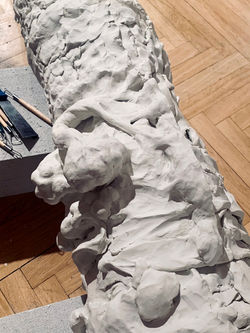Jaro Varga
I found it somewhere but I cannot find it
site specific interactive installation, plasticine
photo: Peter Sit and artist's archive
2021
***for Slovak scroll down***
Jaro Varga’s process art in the form of a monumental plasticine column is a reaction to the theme of the absence of memory, erasure and a non-existent memorial. The artist is following on from his earlier project carried out in Martin in 2012. Then, he left ephemeral traces of removed commemorative plaques on the facades of houses, or on the gate of the national cemetery. The sites were chosen based on the results of a survey in which the artist asked people about the apparent location of a commemorative plaque to the Holocaust. However, this plaque never existed in Martin, and still today there is nothing that refers to this chapter in the town’s history. In the meantime, the theme of an absent sacred place was reopened following the recent discovery of two supporting columns from the demolished synagogue which was still in the centre of Martin in the 1970s. They are probably the only two surviving columns out of the eight which were part of the interior of the synagogue, and also the only two pieces of material evidence and remains of the architecture dating from 1875. They thus naturally became a trigger for a dialogue on a new memorial to fill the empty space left by the synagogue. A third column is now joining the dialogue, placed in the middle of the gallery as one of the missing six. The materialisation of this absence, in a soft and malleable material, reverses the sense of the column as a supporting architectural element, and also puts into question its sense of mental support for a collective memory. Instead, it activates viewers into cooperation by means of its permanent reshaping, modelling and the addition of new semantic layers. It becomes a kind of temporary subversive monument which changes its function from reminding to rediscovering old memories. It is thus a perfect example of James E. Young’s term “Counter-Monument”, which instead of being traditionally static changes incessantly; instead of reassuring, it provokes, challenges one to interact; it does not become eternal, sacred and invisible with the passing of time, but disappears and is open to its own violation which “does not take upon itself the burden of memory with compassion, but throws it back to the feet of the city”. Jaro Varga’s temporary counter-monument in the Turiec Gallery invites viewers in the same way to interact by modelling a new relief. The poetics of absence provides a broad premise for the imagination and for one’s own interpretation. From seizing the fragments of the discovered columns to generating new content, transforming the surface of the column into an organic map of individual stories.
Adam Galko
.............................
Procesuálne dielo Jara Vargu v podobe monumentálneho stĺpu z plastelíny reaguje na tému absencie pamäte, vymazávania a neexistujúceho pamätníka. Autor ním nadviazal na svoj starší projekt, ktorý realizoval v Martine už v roku 2012. Na fasádach domov, či na bráne národného cintorína vtedy zanechal efemérne stopy po odstránených pamätných tabuliach. Vybrané miesta boli výsledkom ankety, v ktorej sa autor pýtal ľudí na údajné umiestnenie pamätnej tabule holokaustu. Tá však v Martine nikdy neexistovala, a ani dodnes na túto časť histórie v meste nič neodkazuje. Téma absentujúceho pietneho miesta sa otvorila medzičasom znova, a to po nedávnom objavení dvoch oporných stĺpov zo zbúranej synagógy, ktorá ešte v 70. rokoch minulého storočia tvorila centrum mesta Martin. Ide pravdepodobne o jediné dva zachované stĺpy z ôsmich, ktoré tvorili súčasť interiéru synagógy a zároveň jediné dva hmotné dôkazy a pozostatky architektúry z roku 1875. Stali sa tak, prirodzene, aj spúšťačom dialógu o novom pamätníku, ktorý by vyplnil prázdne miesto po synagóge. Do tohto dialógu teraz vstupuje tretí stĺp, položený uprostred galérie, ako jeden zo šiestich, ktoré chýbajú. Zhmotnenie tejto absencie v mäkkom a poddajnom materiáli otáča význam stĺpa ako oporného prvku v architektúre a tiež spochybňuje svoj význam mentálnej opory pre kolektívnu pamäť. Namiesto toho aktivizuje divákov k spolupráci jeho neustálym pretváraním, modelovaním a pridávaním nových vrstiev významov. Stáva sa akýmsi dočasným subverzívnym monumentom, ktorý mení funkciu pripomínania na rozpomínanie. Dokonale tak napĺňa termín „Counter-Monument“ (kontramonumentu) Jamesa E. Younga, ktorý sa namiesto klasickej statickosti neustále mení, namiesto utešovania provokuje, vyzýva k interakcii, nestáva sa večným, posvätným a časom neviditeľným, ale miznúcim a otvoreným k vlastnému narúšaniu, ktorý „neprijíma s ľútosťou bremeno pamäte, ale hádže ho naspäť k nohám mesta.“ Dočasný kontramonument Jara Vargu v Turčianskej galérii, rovnako prizýva divákov k interakcii cez modelovanie nového reliéfu. Poetika absencie pritom poskytuje široký priestor pre imagináciu a vlastnú interpretáciu. Od zachytávania fragmentov z nájdených stĺpov až po generovanie nových obsahov, premieňajúcich povrch stĺpa na organickú mapu individuálnych príbehov.
Adam Galko
 |  |
|---|---|
 |  |